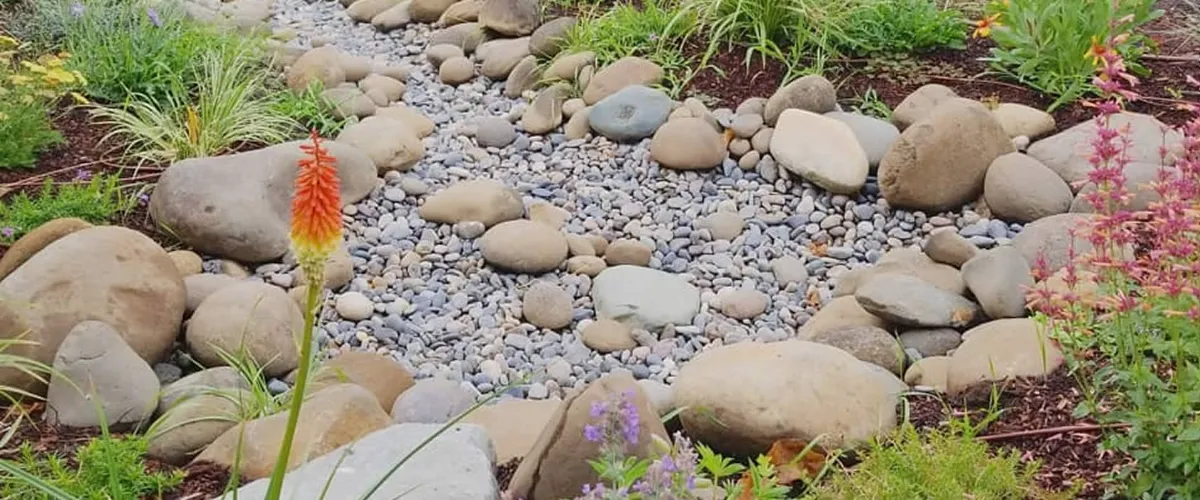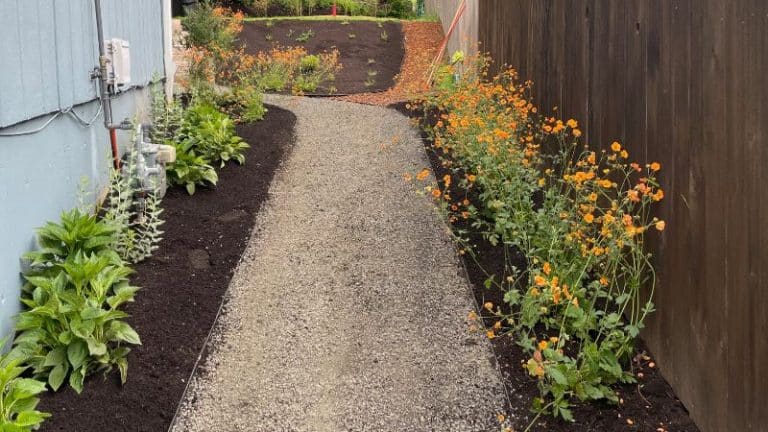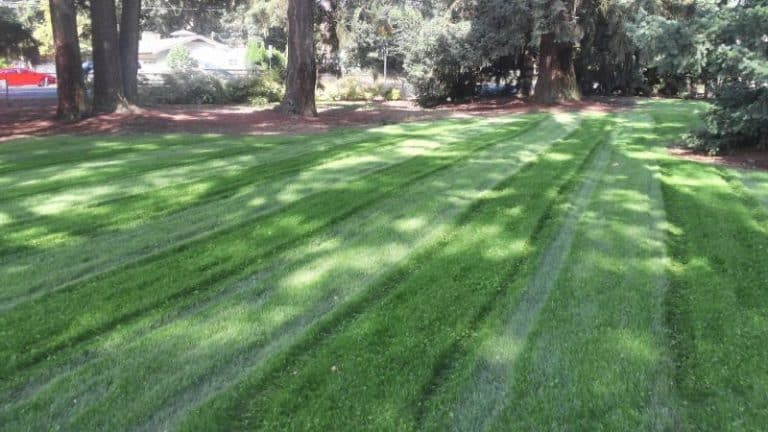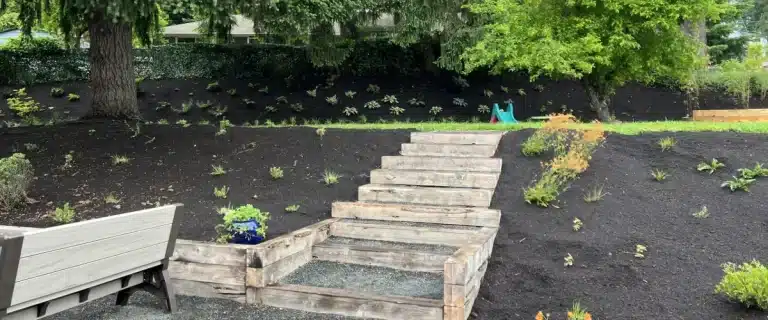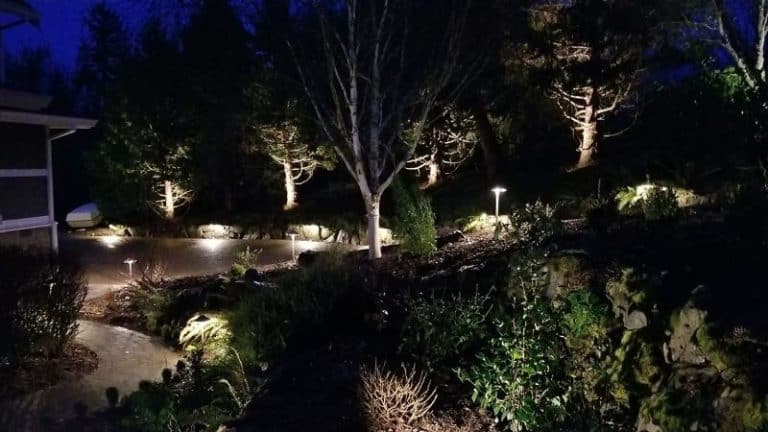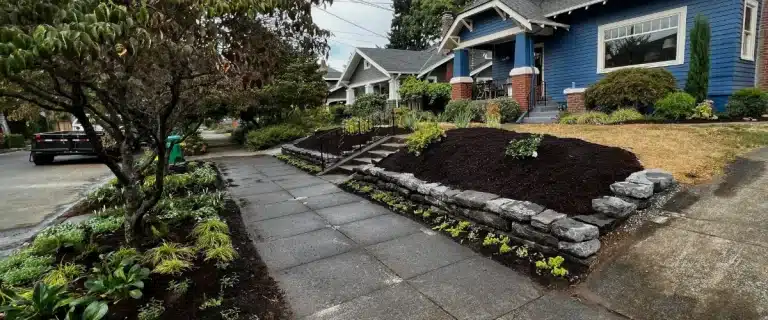Incorporating a Dry Creek Bed into Your Oregon Landscape
A dry creek bed, also known as an arroyo or dry stream, is a landscaping feature that simulates a natural watercourse but it only fills with water during periods of heavy rain. Beyond its aesthetic appeal, it serves practical purposes such as managing stormwater runoff, preventing erosion, and guiding rainwater away from structures.
For Oregon homeowners, integrating a dry creek bed can harmonize your landscape with the region's natural beauty while addressing drainage challenges.
Understanding Dry Creek Beds
A dry creek bed is a shallow trench lined with stones and filled with river rocks or gravel, designed to mimic the appearance of a dried-up stream. During rainfall, it channels water flow, reducing erosion and promoting groundwater recharge. When dry, it adds texture and visual interest to your landscape.
Benefits:
-
- Erosion Control: Stabilizes soil and prevents washouts.
- Drainage Improvement: Directs excess water away from foundations and low spots.
- Aesthetic Enhancement: Adds a naturalistic element that complements various landscape styles.
Planning and Preparation
Proper planning ensures your dry creek bed is both functional and visually appealing.
Site Assessment:
-
- Identify Water Flow Patterns: Observe your property's drainage during heavy rains to determine the best location for the creek bed.
- Slope Consideration: A slight slope facilitates water movement; however, avoid steep grades to prevent rapid runoff.
Design Considerations:
-
- Naturalistic Layout: Design gentle curves and varying widths to emulate a natural stream.
- Depth and Width: Typically, 1-2 feet deep and 2-3 feet wide, adjusted based on your property's scale and water flow. The beauty of these features is that they are highly customizable.
Preparation Steps:
-
- Mark the Path: Use marking paint or a garden hose to outline the desired course.
- Excavate: Dig along the marked path, creating a concave trench with sloping sides.
- Install Landscape Fabric: Line the trench to prevent weed growth and soil erosion.
Selecting Appropriate Rocks
Choosing the right stones enhances both function and appearance.
Types of Rock:
-
- River Rocks: Smooth, rounded stones that mimic water-worn pebbles, ideal for the creek bed's base.
- Cobblestones: Larger, rounded stones that add texture and visual interest.
- Boulders: Strategically placed to create focal points and emulate natural stream features.
Rock Sourcing:
-
- Local Quarries: We utilize native stones to ensure regional compatibility and reduce environmental impact.
- Reclaimed Materials: Incorporate salvaged rocks for sustainability and cost-effectiveness.
Incorporating Native Oregon Plants
Enhancing your dry creek bed with native Oregon plants not only elevates its aesthetic appeal but also supports local ecosystems by providing habitat and food sources for indigenous wildlife. Native plants are well-adapted to the regional climate and soil conditions, making them resilient choices for sustainable landscaping.
Recommended Native Plants:
-
- Sword Fern (Polystichum munitum): An evergreen fern with graceful, arching fronds that thrive in shaded areas. Its lush foliage adds texture and year-round interest to your landscape.
- Oregon Grape (Mahonia aquifolium): An evergreen shrub featuring holly-like leaves and bright yellow flowers in spring, followed by deep blue berries. It is tolerant of various conditions and adds vibrant color to your garden.
- Red Flowering Currant (Ribes sanguineum): A deciduous shrub with vibrant pink to red flowers that bloom in early spring, attracting hummingbirds and bees. Its foliage turns a pleasing yellow in the fall.
- Kinnikinnick (Arctostaphylos uva-ursi): A low-growing evergreen groundcover with small, leathery leaves and red berries. It is drought-tolerant and excellent for erosion control.
- Nootka Rose (Rosa nutkana): A wild rose with fragrant pink blooms that provide habitat and food for wildlife. Its thorny stems can also serve as a natural barrier.
Additional Native Plant Suggestions:
-
- Creeping Oregon Grape (Mahonia repens): Similar to Oregon Grape but with a lower, spreading habit, making it ideal for groundcover. It produces yellow flowers and blue-black berries, and its foliage turns reddish-purple in winter.
- Manzanita (Arctostaphylos spp.): Known for its smooth, reddish bark and clusters of white to pink urn-shaped flowers, manzanita is drought-tolerant and adds architectural interest to the landscape.
- Sharpleaf Penstemon (Penstemon acuminatus): This perennial produces tubular blue to violet flowers that attract pollinators. It is well-suited for dry, sandy soils and adds vertical interest.
Dry Stream Planting Tips:
-
- Cluster Plantings: Group plants in naturalistic patterns to mimic wild growth. This approach creates a more authentic and cohesive look, enhancing the ecological function of your landscape.
- Consider Sun Exposure: Match plant selections to the site's light conditions for optimal growth. For instance, sword ferns prefer shaded areas, while manzanitas thrive in full sun.
- Soil Preparation: Ensure proper soil drainage to accommodate the needs of these native plants. Amending the soil with organic matter can improve its structure and fertility.
- Maintenance: While native plants are adapted to local conditions, regular monitoring for invasive species and occasional pruning will help maintain the health and appearance of your dry creek bed.
By thoughtfully selecting and placing native Oregon plants around your dry creek bed, you create a harmonious and sustainable landscape feature that reflects the natural beauty of the region.
Strategic Placement of a Dry Creek Bed in Your Oregon Landscape
Integrating a dry creek bed into your property requires thoughtful planning to maximize both its functional benefits and aesthetic appeal. By selecting the optimal location, you can effectively manage water runoff, prevent erosion, and enhance the visual interest of your landscape.
Ideal Locations for a Dry Creek Bed:
Low-Lying Areas: Installing a dry creek bed in depressions where water naturally accumulates can facilitate efficient drainage. This placement allows the creek bed to channel excess water away from your home's foundation, reducing the risk of water damage and soil erosion.
Along Slopes: Positioning a dry creek bed along natural slopes helps slow down water runoff, minimizing erosion and promoting groundwater recharge. The creek bed acts as a conduit, guiding water gently down the slope while preventing the loss of valuable topsoil.
Near Downspouts: Placing a dry creek bed beneath roof downspouts effectively channels rainwater away from your home's foundation. This strategy not only protects the structural integrity of your property but also adds a decorative element to areas that might otherwise be prone to erosion.
Integration with Existing Landscape Features:
Pathways: Aligning a dry creek bed alongside walkways creates a harmonious and cohesive design. The meandering lines of the creek bed can complement the straight edges of a path, adding a sense of movement and natural flow to your garden.
Patios and Decks: Positioning a dry creek bed near outdoor living spaces like patios or decks enhances the ambiance by introducing a naturalistic element. The visual and auditory appeal of a well-designed creek bed can create a tranquil environment for relaxation and entertainment.
Additional Considerations:
Natural Water Flow Observation: Before deciding on the placement, observe how water flows across your property during rainfall. Identifying natural drainage patterns will inform the most effective location for your dry creek bed.
Aesthetic Design: Incorporate curves and varying widths in your creek bed to emulate the appearance of a natural stream. Adding elements like strategically placed boulders, gravel, and appropriate vegetation can enhance the realism and beauty of the feature.
Functional Depth and Width: Tailor the dimensions of your dry creek bed to accommodate the volume of water typical to your area. Ensuring the creek bed is appropriately sized will enhance its effectiveness in managing runoff and preventing overflow.
By thoughtfully selecting the location and design of your dry creek bed, you can create a functional feature that not only addresses practical concerns like drainage and erosion but also elevates the overall aesthetic of your Oregon landscape.
White Oak Landscapes: Your Partner in Landscape Transformation
At White Oak Landscapes, we specialize in creating functional, sustainable, and beautiful outdoor spaces tailored to Oregon's unique environment.
Our Expertise:
-
- Customized Design: We collaborate with you to design a dry creek bed that complements your property's aesthetics and addresses specific drainage needs.
- Quality Craftsmanship: Our team ensures meticulous installation using high-quality materials and native plants.
- Sustainable Practices: We prioritize eco-friendly methods that promote local biodiversity and environmental health.
Our Oregon Service Area
We proudly install dry creeks and streams in the following communities across Oregon:
-
- Oregon City, OR
- Milwaukie, OR
- Lake Oswego, OR
- West Linn, OR
- Damascus, OR
- Portland, OR
- Tualatin, OR
Ready to Transform Your Landscape with a Dry Creek Bed?
Incorporating a dry creek bed into your Oregon property not only enhances its aesthetic appeal but also offers practical benefits such as improved drainage and erosion control. At White Oak Landscapes, we specialize in designing and installing custom dry creek beds that harmonize with the natural beauty of the Pacific Northwest.
Give us a call (503) 387-7311 or fill out our consultation form and we'll get right back to you.

